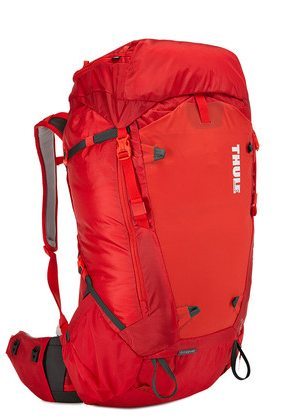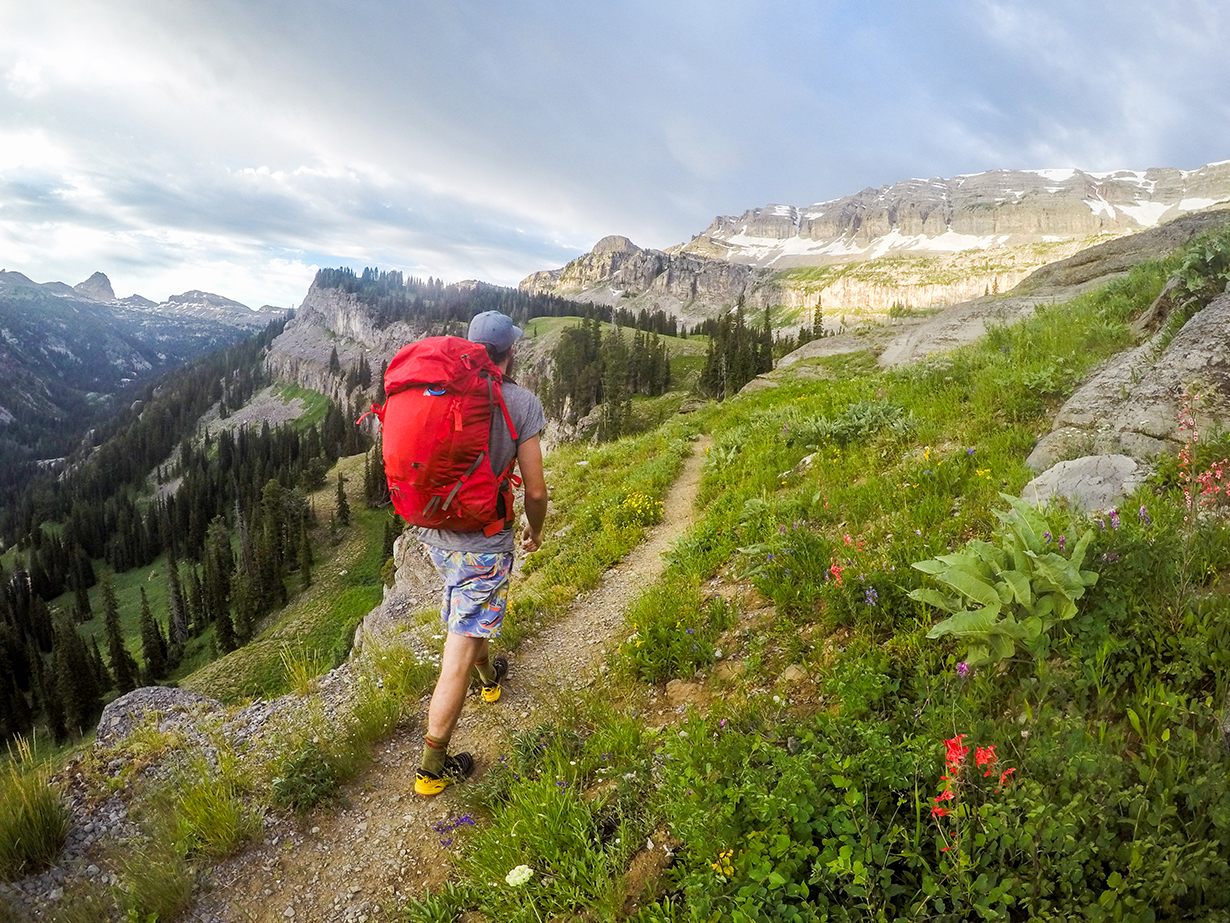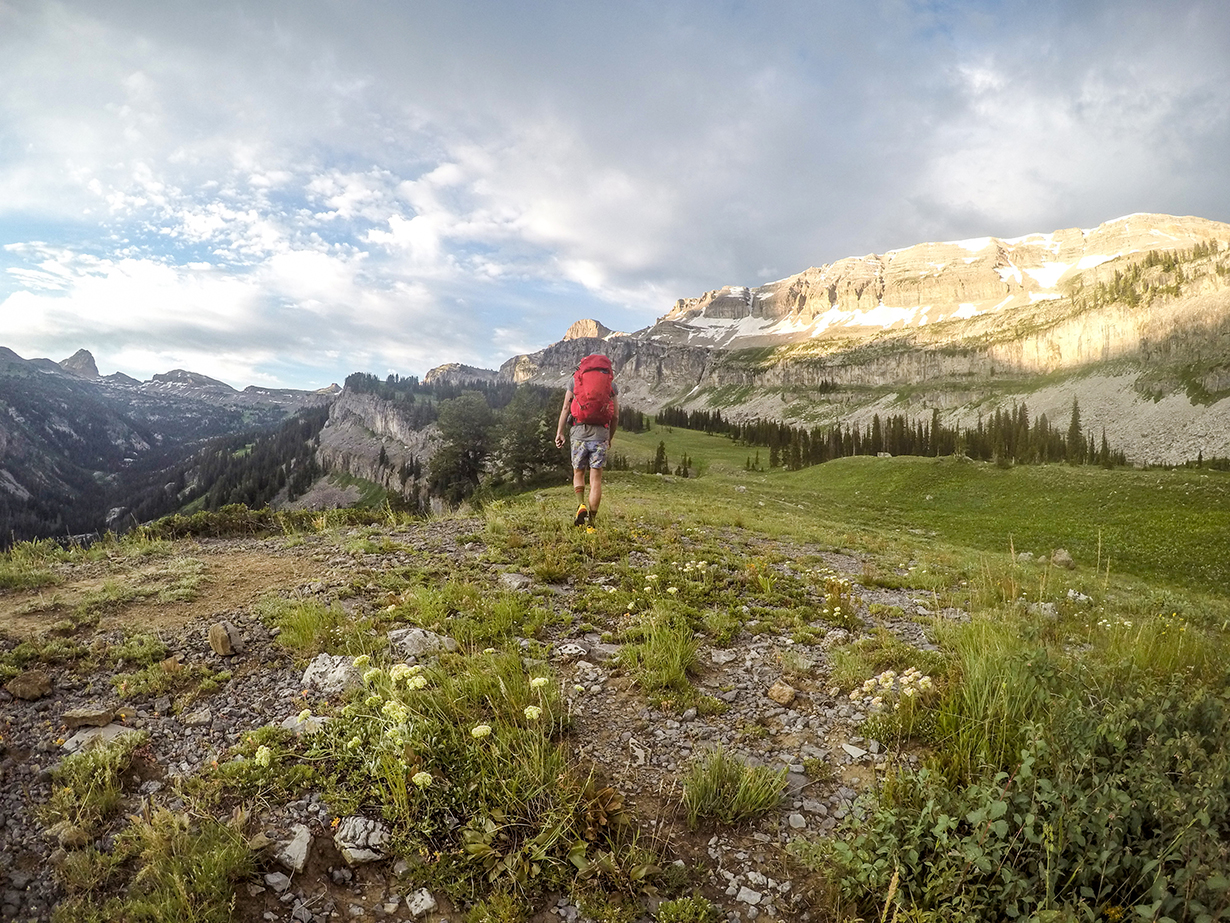
Stated Weight: 4.14 pounds
Thule Versant 60L Backpack
Volume: 60 Liters
Blister’s Measured Weight: 4.46 pounds (2023 g)
Stated Features:
- Easily customizable with 12 cm /4.75 in of torso and 10 cm / 4 in of hipbelt adjustability
- Removable, VersaClick waterproof rolltop pocket keeps gear safe from elements
- Customizable hipbelt compatible with interchangeable VersaClick accessories (sold separately)
- StormGuard system combines a partial rain cover with a waterproof bottom liner to create a fully weather proof bag
- StormGuard provides better access, keeps gear drier and is more durable than a traditional rain cover
- Side pockets are easily accessible even with rain cover on
- Top lid converts to a sling pack for summit hikes
- Large U-zip panel allows for easy access
- Two attachment loops for hiking poles or ice axes
- Front shove-it pocket for quick access
MSRP: $259
Reviewer: 6’, ~180 lbs
Test Locations: Teton Canyon, WY; Dworshak Reservoir, Idaho
Days Used: 4
Intro
David Steele and I were both very impressed by Thule’s Upslope 35L backpack this past winter, and I’ve continued to use mine for day hikes this summer. So when it came time to evaluate higher-volume options for summer backpacking, we were curious to see how well Thule’s larger packs worked. Thule’s Versant 60L doesn’t have that one obvious game-changing feature that jumps out like the Upslope 35L’s magical hip belt pockets, but it looked like a competent pack from a relative newcomer to the game.
Options
Thule also makes 50 and 70 L versions of the Versant, but they say the Versant 60L is “perfectly sized for 3-5 day adventures.” And that seems about right to me, though if you pack smart, you could go quite a few more days in a pack this size.
Fit and Comfort
Thule only makes one size of the men’s Versant 60L (they do offer a slightly smaller women’s version) and it relies on both torso and hip belt adjustability to dial in your fit. The Versant 60L has 12 cm of torso adjustability and 10 cm of hip belt adjustability, and both are accessed by large velcro patches. I was able to quickly dial in my size, and I have plenty of room to go bigger or smaller, although, at 6’0”, I sit closer to the top end of the adjustment range.

The fit of a pack is a very important and personal thing. In the past my back has gotten along very well with several Black Diamond packs, and I had a great experience borrowing David Steele’s Osprey Variant. Conversely, I haven’t had great luck with Mammut packs, they just haven’t fit my back as well (hopefully that experience changes as I dive into my review of the Mammut Lithium Crest). All that to say: what works for my back may not work for yours, so it’s always a good idea to try on a pack—with weight in it—at a shop.
So far, I’ve had a great experience with the Versant 60L. Fully loaded down and in rough terrain, I haven’t had any hot spots or weird rubbing. Its shoulder straps aren’t the widest or beefiest, but the hip belt does a good job of taking most of the load, without doing a number on my pelvis.
I have found that the Versant doesn’t breathe as well as some other packs I’ve used that featured more molded and contoured back panels. It definitely runs warmer than the Black Diamond Mercury 75 I’d been using before, but it’s not terribly hot.
Weight
That comfort carrying heavy loads and adjustability do come at a cost, though. At our measured weight of 4.46 lbs, the Versant 60L weighs significantly more than (a more stripped-down) pack like the Black Diamond Mission 75 (stated 3.63 lbs in a size Large), but less than the Osprey Atmos AG 65 (stated 4.92 lbs in a size Large), or the Black Diamond Mercury 65 (stated 4.75 lbs in a size Large). The Versant certainly feels hefty when empty, but it hides that weight well on the trail.
Suspension
In the past I’ve been a fan of Black Diamond’s ergoACTIV XP suspension system found on the Mercury 75. I found the pivoting hip belt was comfortable (even during some pretty creative scrambling moves) and it was easily adjustable when I needed more or less movement out of the pack.
Switching to the Versant 60, I was worried that I was going to miss that pivot and freedom of movement. But so far, I don’t have any complaints. The Versant 60’s hip belt is well padded, and while there are no activator straps to cinch it down, the velcro adjustment system makes it pretty easy to dial in the fit.
While it doesn’t have the most beefy or refined suspension around, the Versant feels just fine hiking with heavy loads.
Really, the biggest issue I’ve had with the Versant 60 revolves around the sternum strap. It slides easily up and down to adjust to your chest, but it doesn’t have an elastic portion like most other packs do. That means that it can’t stretch and expand as the load bounces, which causes it to migrate up my sternum from where I originally place it. Admittedly, this is a weird problem to have, and not one I’ve run into with any other pack. But I did find it frustrating that the sternum strap would never stay put. It would be a reasonably easy swap to put an elastic strap on, but it’s a weird oversight that I’ve never seen on another pack.
Pockets and Brain
The Versant’s main pocket is very simple. There’s a hydration sleeve, and a large U-shaped zipper flap to access the main drawstring pocket, but there are no internal dividers or mesh organizer pockets. That’s not a huge deal, though I do like having a smaller mesh pocket or two to stash smaller items in.
There’s a big, stretchy pocket on the back of the pack that’s secured at the top by a single buckle. This pocket is perfect for stuffing extra layers, and I usually stash an extra Platypus bottle of water there, too.
There is also a stretchy pocket on either side of the pack that easily hold a water bottle or bear spray, and they are accessible without taking the pack off.

The brain has three pockets: a smaller one on the top that’s perfect for a wallet, keys, and sunglasses; the main pocket which can fit a lot of food or a DSLR; and a smaller pocket on the bottom that comes with a shoulder strap in it to transform the brain into a hip bag.
Unlike some packs where the brain is a real pain to remove from the pack, the Versant’s brain is just attached by two buckles and a cinch strap, so it’s easy to use separately, then throw back on for the hike out.
NEXT: Other Features: Loops, Pockets, and Rainfly
